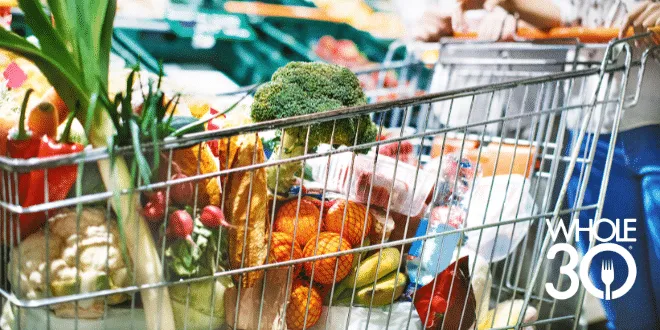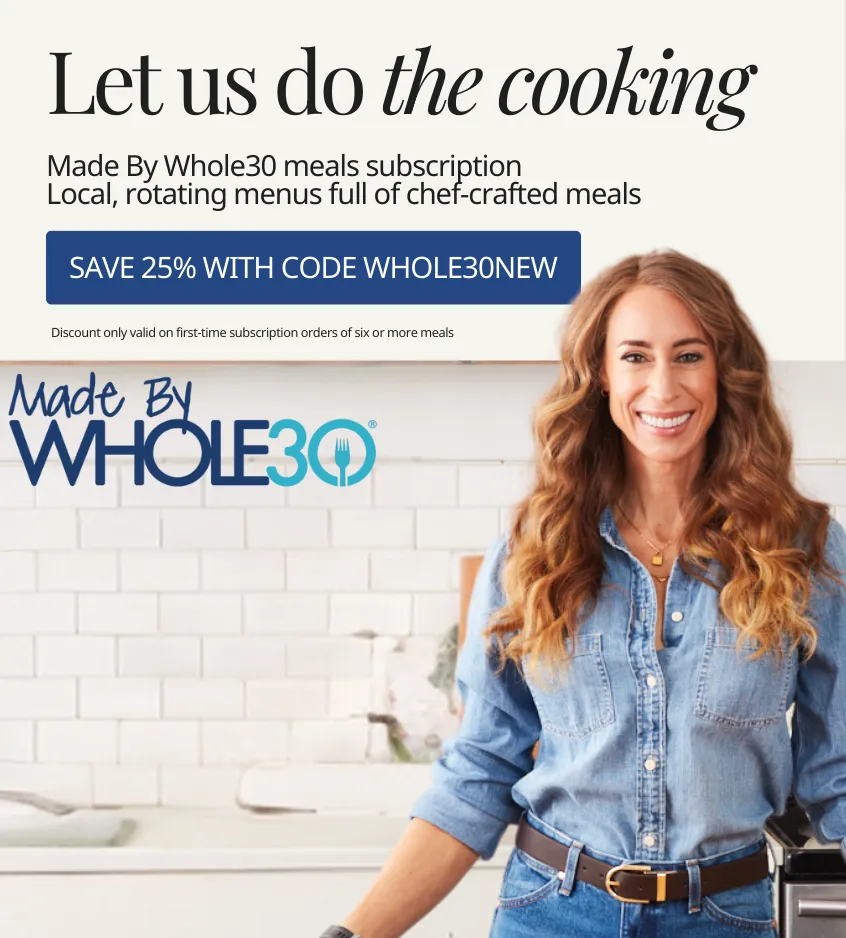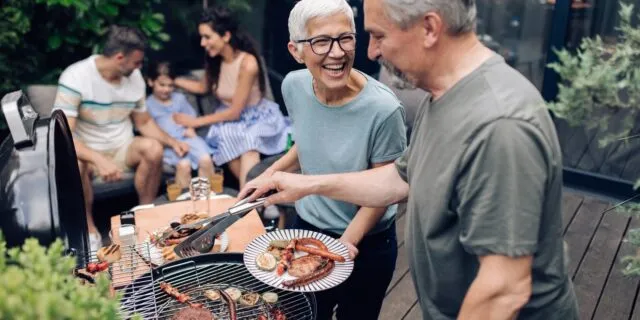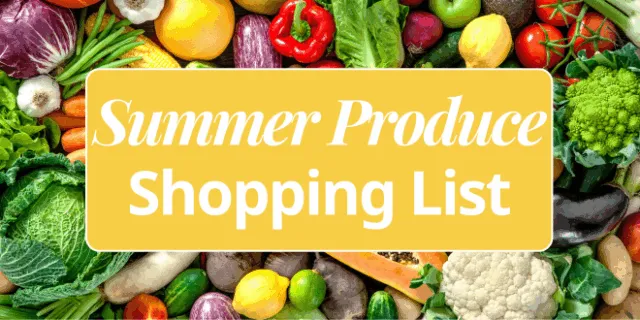By Autumn Michaelis, author of Whole Food for Your Family
Can I eat Whole30 on a budget? This is a question I get a LOT. And the answer is YES: you can be successful even if you don’t have access to specialty natural food stores or convenience products.
I know firsthand how expensive it can be to feed a family. We’re a family of 7 (5 of which are 6’+ growing boys I call my “walking stomachs”). In the early days, we lived off of food stamps and WIC. And now, we still stick to a strict budget. I’ve got lots of strategies and tips for doing Whole30 on a budget. Here are five of the most important.
I know that having the time and resources to feed my family a particular way (such as Whole30, Paleo, AIP, etc.) is a privilege. I hope my budget-friendly recipes and tips make eating this way more approachable, but I acknowledge that even still, it is not accessible to everyone.
Whole30 on a budget tip #1: Stick to your list + shop around
Meal plan, shop with a list, and stick to that list. Every time you walk into a store, you open up the potential to overspend. When you go to a store without a meal plan and specific list, you will pick up items you don’t actually *need* or forget some of the things you DID need. If you’re doing your Whole30 on a budget you can’t afford to not meal plan, but it doesn’t have to be complicated. Watch a video on my easy approach to meal planning here.
My one exception to sticking to my list: if you see a great deal on something you know you will use? Stock up! (If your budget allows). For example, I know we use a lot of canned tomatoes. If I see them on sale for half their normal price, I buy 8 instead of the 2 I needed that week. Just make sure you consider the shelf or freezer life of the item and only buy if you are confident you will use it before then.
Shop around! Get to know which store has the best price for almond flour or chicken breast, as well as what a typical price is for your food staples, so you know a good deal when you see it. Be sure to check sale prices in ads or apps at your favorite stores before you head out to the store!
Do I go to more than one store to do my grocery shopping? I absolutely do. I have found that getting only the most affordable items and best deals from 2-3 stores is worth the time and gas instead of overpaying for all items by shopping at one store. The grocery stores our family mainly shop at are Walmart and Winco (the west-coast version of Aldi).
Budget tip #2: Waste not, want not
The average U.S. household throws out 31.9% of its food*. The total annual cost of the wasted food was estimated to be $240 billion or $1,866 per household (that’s around $150 per month!) (*According to a study published in the American Journal of Agricultural Economics). You spent that hard-earned money on those groceries, don’t let it go to the trash can! Having a meal plan, making a list and sticking to it prevents that waste and helps you succeed with your Whole30 on a budget. Here’s three ways to prevent that:
- Set aside a regular rhythm to eat your leftovers. My husband and I eat dinner leftovers for lunch. Also, in our house, the weekend is the time I use up all the leftovers or cook up about-to-spoil veggies. Saturday night dinner is always a “get it yourself” dinner where we empty out, eat up, or freeze any leftovers.
- Not gonna eat it right away? Freeze it! Most cooked foods can last months in the freezer. This is a great solution for food you are tired of eating or can’t eat before it goes bad. Plus, freezer leftovers are perfect for getting dinner on the table in a pinch.
- Shop your own pantry before you go to the store. I do this simply by making my grocery list of everything I need to make the planned meals, then taking it to the pantry and crossing off the items I already have. I once bought Dijon mustard every other week for 12 weeks because I kept forgetting if I had it on hand or not. Shopping my pantry would have prevented that!
Whole30 on a budget tip #3: Make it yourself!
Pre-made products are convenient, but you pay for it. For example, Whole30 compatible mayo from the store is usually around $8-10 for 12 ounces. You can make that from scratch for around $3. Plus it’s super empowering … I am convinced making your own mayo is as close to kitchen magic as it gets!
Below are some Whole30 pantry staples that can save you money from my blog, and there’s a whole chapter more of these in my cookbook!
- Whole30 Mayo
- Whole30 BBQ Sauce
- Whole30 Date Mustard (my favorite dressing and dipping sauce!)
- Whole30 Ranch or Cilantro Ranch
- Whole30 Taco Seasoning
- Whole30 3-Minute Blender Salsa
Tip #4: Make do, or do without
Growing up, my mom always loved the saying, “Use it up, wear it out, make do, or do without!”
“Make do, or do without” on a budget means knowing what foods you can swap out and when you can leave it out. For example, with my Whole30 Chicken Nuggets or Chicken Zucchini Nuggets sometimes I get ground turkey instead of ground chicken if it’s cheaper, as they are very interchangeable. In most soups like my Whole30 Chili any ground meat that is accessible for you works. Or in my homemade bbq sauce recipe, coconut aminos can be expensive or hard to find, depending on what stores you live by. That recipe also works without that ingredient, as it already has so many flavors.
One of my favorite budget swaps is using dried herbs vs. fresh. Fresh almost always tastes better … but can get pricey. Did you know you can usually swap dried herbs with fresh? Just use 1/3 the amount! So if it calls for 3 tablespoons chopped basil, you can use 1 tablespoon dried instead. Dried herbs last a lot longer than fresh too, so less chance of them spoiling and ending in the trash.
Whole30 on a budget tip #5: Let good enough be good enough
This last tip is based on a common Whole30 catchphrase, “Let good enough be good enough.” I’m not talking about not being compatible with the Whole30 Rules. I’m talking about not feeling like you have to be able to purchase organic or grass-fed everything to be successful at Whole30 or healthy eating because YOU DON’T. Are organic veggies and responsibly raised meat sources ideal? Absolutely! No one here is arguing that. But, if you are truly on a budget, you can barely (or not at all) afford regular steak, no less grass-fed.
To be honest – my family does not eat grass-fed meat or all organic produce. Gasp. (There, I said it.) Our food budget is already stretched so much to make whole food eating for 7 work, that’s not an option for us. I’d love to, but it just isn’t happening. My family has still seen INCREDIBLE benefits from whole food and Whole30 eating without it.
Do what you can on quality and let good enough be good enough! A home-cooked meal or eating lots of fresh produce is still an awesome success, regardless if the meat is grass-fed or the fresh produce is organic or not.
Want more budget and family-friendly recipes and tips? I put all of my best money-saving strategies and recipes into Whole Food for Your Family, the newest Whole30 Endorsed cookbook. Order a copy of my Whole30 Endorsed cookbook: Whole Food for Your Family.
















